Coventry University MBA IT: Project Scope Change at Omantel Company
VerifiedAdded on 2019/10/31
|102
|23103
|30
Thesis and Dissertation
AI Summary
This MBA (IT) dissertation from Coventry University Middle East College investigates the effects of project scope changes on project objectives at Omantel Company. The research explores the background, aims, objectives, and research questions related to project scope management. It reviews relevant literature, including complexity and disruption theories, and examines the causes, processes, challenges, and influence of IT on scope change. The methodology employs a mixed-methods approach, using both qualitative and quantitative data collection techniques, including surveys and interviews. The analysis of the data, presented through tables and figures, reveals the impact of scope change on various aspects of the project, such as budget, time, employee morale, and business needs. The findings, conclusions, and recommendations are presented, offering insights for future research and improved project management practices within Omantel and the telecommunications industry. The study emphasizes the importance of controlling scope change to mitigate risks and achieve project objectives.
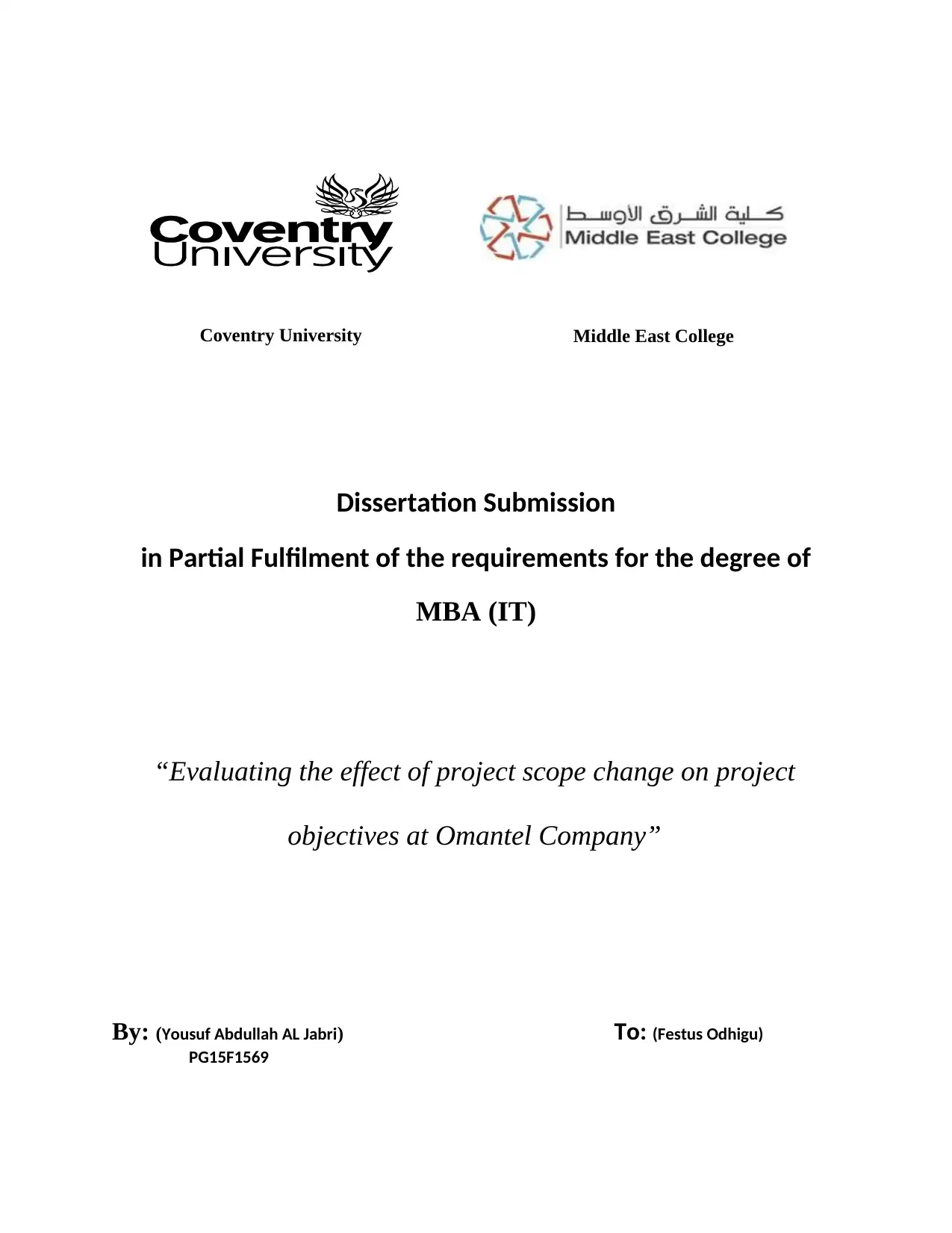
Coventry University Middle East College
Dissertation Submission
in Partial Fulfilment of the requirements for the degree of
MBA (IT)
“Evaluating the effect of project scope change on project
objectives at Omantel Company”
By: (Yousuf Abdullah AL Jabri) To: (Festus Odhigu)
PG15F1569
Dissertation Submission
in Partial Fulfilment of the requirements for the degree of
MBA (IT)
“Evaluating the effect of project scope change on project
objectives at Omantel Company”
By: (Yousuf Abdullah AL Jabri) To: (Festus Odhigu)
PG15F1569
Paraphrase This Document
Need a fresh take? Get an instant paraphrase of this document with our AI Paraphraser
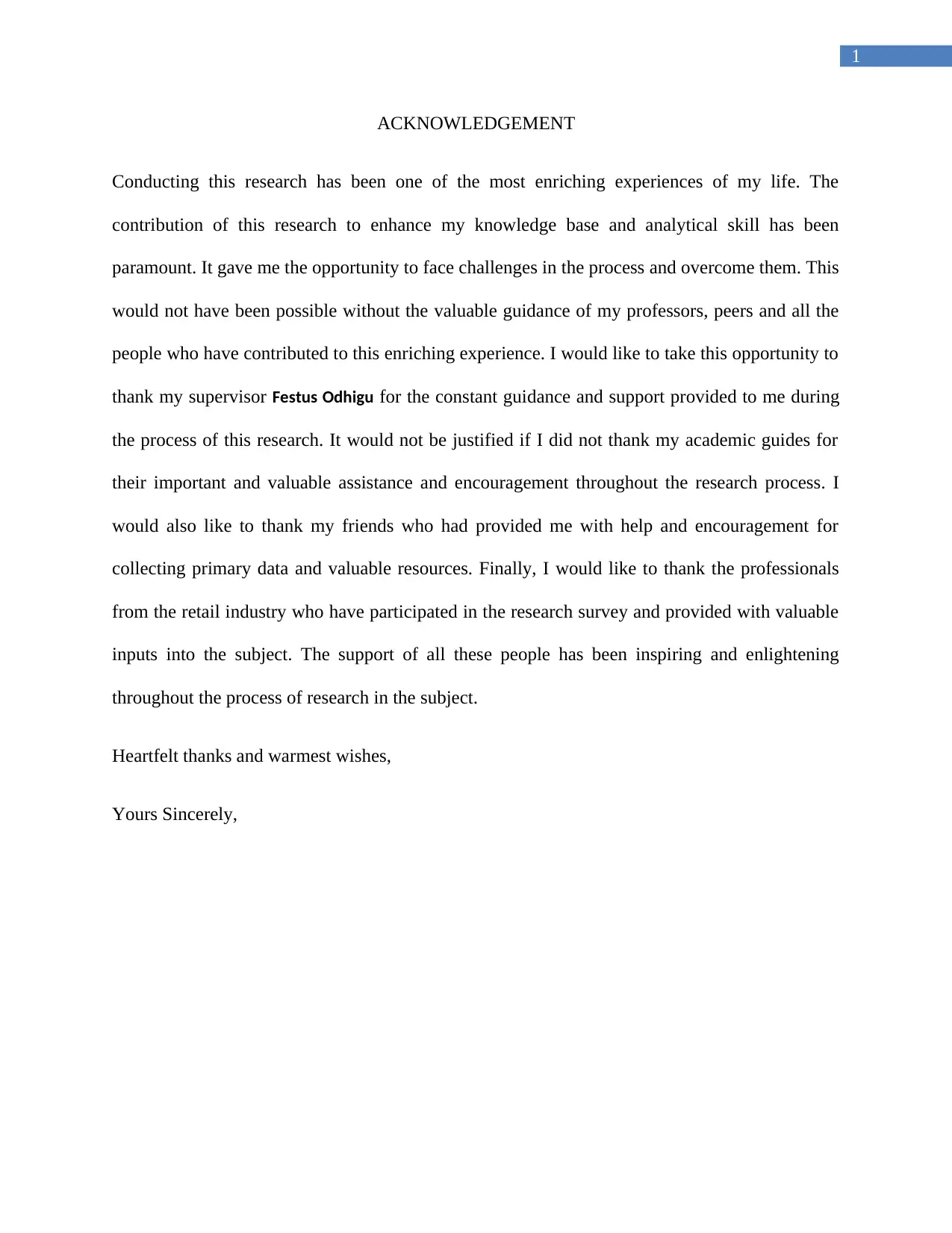
1
ACKNOWLEDGEMENT
Conducting this research has been one of the most enriching experiences of my life. The
contribution of this research to enhance my knowledge base and analytical skill has been
paramount. It gave me the opportunity to face challenges in the process and overcome them. This
would not have been possible without the valuable guidance of my professors, peers and all the
people who have contributed to this enriching experience. I would like to take this opportunity to
thank my supervisor Festus Odhigu for the constant guidance and support provided to me during
the process of this research. It would not be justified if I did not thank my academic guides for
their important and valuable assistance and encouragement throughout the research process. I
would also like to thank my friends who had provided me with help and encouragement for
collecting primary data and valuable resources. Finally, I would like to thank the professionals
from the retail industry who have participated in the research survey and provided with valuable
inputs into the subject. The support of all these people has been inspiring and enlightening
throughout the process of research in the subject.
Heartfelt thanks and warmest wishes,
Yours Sincerely,
ACKNOWLEDGEMENT
Conducting this research has been one of the most enriching experiences of my life. The
contribution of this research to enhance my knowledge base and analytical skill has been
paramount. It gave me the opportunity to face challenges in the process and overcome them. This
would not have been possible without the valuable guidance of my professors, peers and all the
people who have contributed to this enriching experience. I would like to take this opportunity to
thank my supervisor Festus Odhigu for the constant guidance and support provided to me during
the process of this research. It would not be justified if I did not thank my academic guides for
their important and valuable assistance and encouragement throughout the research process. I
would also like to thank my friends who had provided me with help and encouragement for
collecting primary data and valuable resources. Finally, I would like to thank the professionals
from the retail industry who have participated in the research survey and provided with valuable
inputs into the subject. The support of all these people has been inspiring and enlightening
throughout the process of research in the subject.
Heartfelt thanks and warmest wishes,
Yours Sincerely,

2
Abstract
This research talks about the effect if the scope change in the project of the Omantel Company.
Various concepts of the project management have been discussed in this research. The scope of
the project is to analyze the change in the scope of the project and its impact in the company.
Various theories and models including Complexity theory and Disruption theory have been
discussed in this research study for gathering knowledge about scope change. Mixed method of
data collection has been used in this research in order to collect data and information. Both
qualitative and quantitative data analysis method have been used in this research. Online survey
questionnaire and interview have been organized to gather data and information related to the
research. The scope change in a project can result to adjustment of the activities and it can
provide satisfaction to the beneficiaries. The outcomes of research have fulfilled the objectives
and aim of the research.
Table of Contents
Chapter 1: Introduction..................................................................................................................10
1.1 Background of the Study.........................................................................................................10
1.2 Statement of the research problem..........................................................................................12
1.3 Aims and objectives of the study.............................................................................................13
Abstract
This research talks about the effect if the scope change in the project of the Omantel Company.
Various concepts of the project management have been discussed in this research. The scope of
the project is to analyze the change in the scope of the project and its impact in the company.
Various theories and models including Complexity theory and Disruption theory have been
discussed in this research study for gathering knowledge about scope change. Mixed method of
data collection has been used in this research in order to collect data and information. Both
qualitative and quantitative data analysis method have been used in this research. Online survey
questionnaire and interview have been organized to gather data and information related to the
research. The scope change in a project can result to adjustment of the activities and it can
provide satisfaction to the beneficiaries. The outcomes of research have fulfilled the objectives
and aim of the research.
Table of Contents
Chapter 1: Introduction..................................................................................................................10
1.1 Background of the Study.........................................................................................................10
1.2 Statement of the research problem..........................................................................................12
1.3 Aims and objectives of the study.............................................................................................13
⊘ This is a preview!⊘
Do you want full access?
Subscribe today to unlock all pages.

Trusted by 1+ million students worldwide
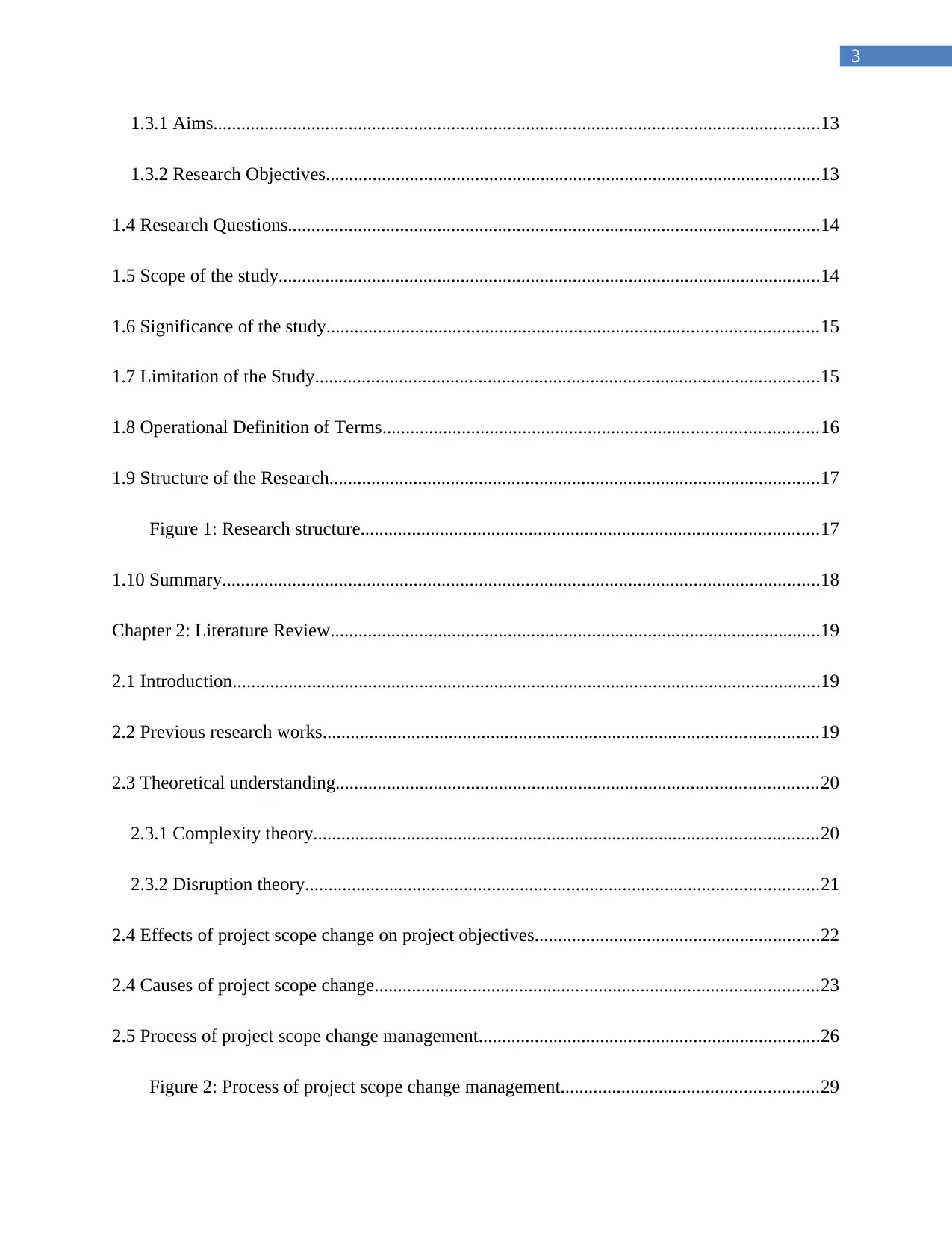
3
1.3.1 Aims..................................................................................................................................13
1.3.2 Research Objectives..........................................................................................................13
1.4 Research Questions..................................................................................................................14
1.5 Scope of the study....................................................................................................................14
1.6 Significance of the study.........................................................................................................15
1.7 Limitation of the Study............................................................................................................15
1.8 Operational Definition of Terms.............................................................................................16
1.9 Structure of the Research.........................................................................................................17
Figure 1: Research structure..................................................................................................17
1.10 Summary................................................................................................................................18
Chapter 2: Literature Review.........................................................................................................19
2.1 Introduction..............................................................................................................................19
2.2 Previous research works..........................................................................................................19
2.3 Theoretical understanding.......................................................................................................20
2.3.1 Complexity theory............................................................................................................20
2.3.2 Disruption theory..............................................................................................................21
2.4 Effects of project scope change on project objectives.............................................................22
2.4 Causes of project scope change...............................................................................................23
2.5 Process of project scope change management.........................................................................26
Figure 2: Process of project scope change management.......................................................29
1.3.1 Aims..................................................................................................................................13
1.3.2 Research Objectives..........................................................................................................13
1.4 Research Questions..................................................................................................................14
1.5 Scope of the study....................................................................................................................14
1.6 Significance of the study.........................................................................................................15
1.7 Limitation of the Study............................................................................................................15
1.8 Operational Definition of Terms.............................................................................................16
1.9 Structure of the Research.........................................................................................................17
Figure 1: Research structure..................................................................................................17
1.10 Summary................................................................................................................................18
Chapter 2: Literature Review.........................................................................................................19
2.1 Introduction..............................................................................................................................19
2.2 Previous research works..........................................................................................................19
2.3 Theoretical understanding.......................................................................................................20
2.3.1 Complexity theory............................................................................................................20
2.3.2 Disruption theory..............................................................................................................21
2.4 Effects of project scope change on project objectives.............................................................22
2.4 Causes of project scope change...............................................................................................23
2.5 Process of project scope change management.........................................................................26
Figure 2: Process of project scope change management.......................................................29
Paraphrase This Document
Need a fresh take? Get an instant paraphrase of this document with our AI Paraphraser

4
2.6 Challenges in the management of project scope change.........................................................29
2.7 Influence of information technology on project scope management.......................................31
2.8 Gap analysis.............................................................................................................................32
2.9 Conceptual framework.............................................................................................................33
Chapter 3: Research Methodology................................................................................................34
3.1 Introduction..............................................................................................................................34
3.2 Research Onion........................................................................................................................34
Figure 3.1: Research Onion...................................................................................................35
3.3 Research Philosophy................................................................................................................35
Figure 3.2: Research Philosophy...........................................................................................36
3.4. Research Approach.................................................................................................................37
Figure 3.3: Research Approach.............................................................................................38
3.5 Research Design......................................................................................................................38
Figure 3.4: Research Design..................................................................................................39
3.6 Data collection technique........................................................................................................40
3.7 Data collection instruments.....................................................................................................41
3.8 Population of the Study...........................................................................................................42
3.9 Sampling technique and Sample size......................................................................................42
3.10 Data analysis technique.........................................................................................................44
3.11 Research instruments Validity and Reliability Testing.........................................................45
2.6 Challenges in the management of project scope change.........................................................29
2.7 Influence of information technology on project scope management.......................................31
2.8 Gap analysis.............................................................................................................................32
2.9 Conceptual framework.............................................................................................................33
Chapter 3: Research Methodology................................................................................................34
3.1 Introduction..............................................................................................................................34
3.2 Research Onion........................................................................................................................34
Figure 3.1: Research Onion...................................................................................................35
3.3 Research Philosophy................................................................................................................35
Figure 3.2: Research Philosophy...........................................................................................36
3.4. Research Approach.................................................................................................................37
Figure 3.3: Research Approach.............................................................................................38
3.5 Research Design......................................................................................................................38
Figure 3.4: Research Design..................................................................................................39
3.6 Data collection technique........................................................................................................40
3.7 Data collection instruments.....................................................................................................41
3.8 Population of the Study...........................................................................................................42
3.9 Sampling technique and Sample size......................................................................................42
3.10 Data analysis technique.........................................................................................................44
3.11 Research instruments Validity and Reliability Testing.........................................................45
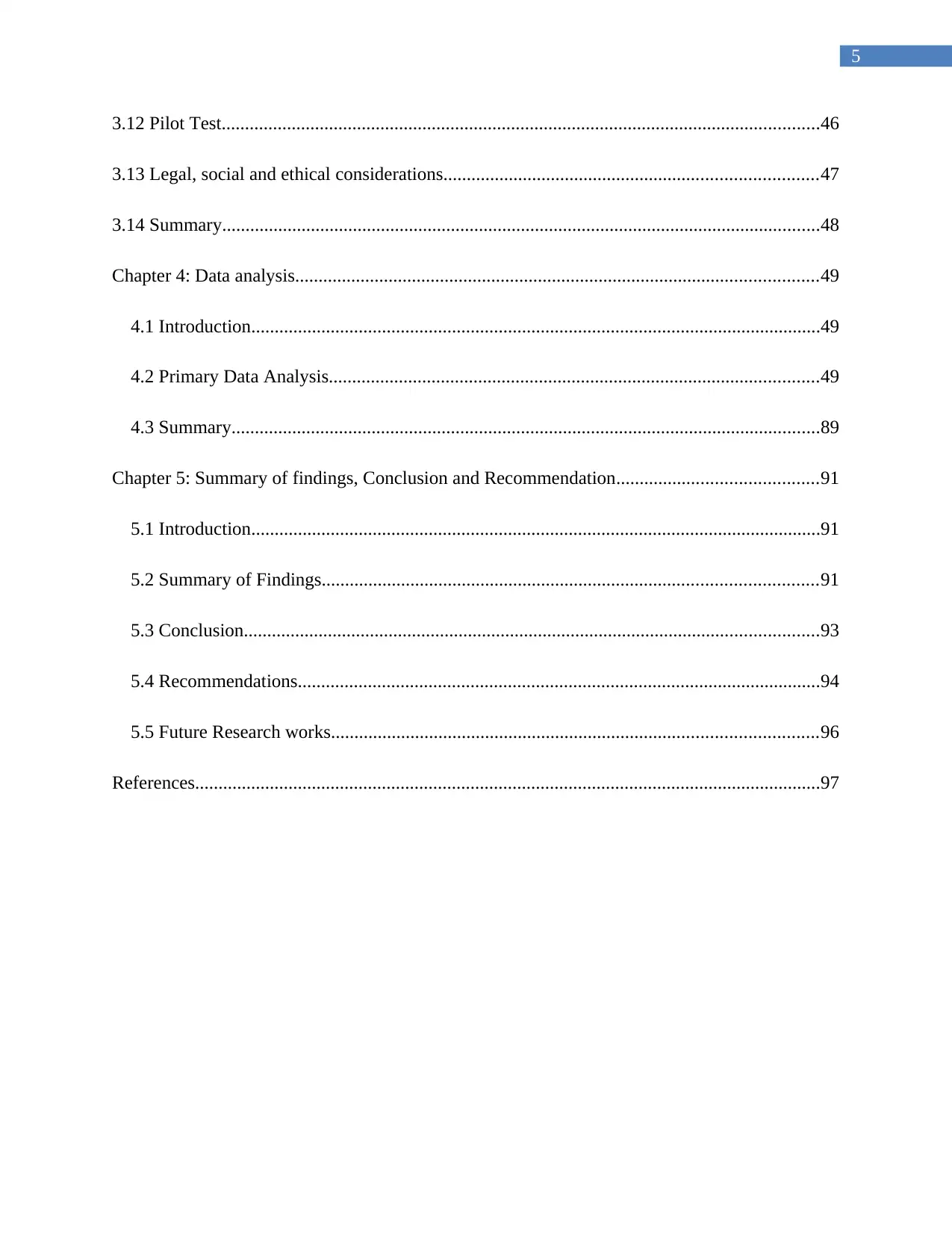
5
3.12 Pilot Test................................................................................................................................46
3.13 Legal, social and ethical considerations................................................................................47
3.14 Summary................................................................................................................................48
Chapter 4: Data analysis................................................................................................................49
4.1 Introduction..........................................................................................................................49
4.2 Primary Data Analysis.........................................................................................................49
4.3 Summary..............................................................................................................................89
Chapter 5: Summary of findings, Conclusion and Recommendation...........................................91
5.1 Introduction..........................................................................................................................91
5.2 Summary of Findings..........................................................................................................91
5.3 Conclusion...........................................................................................................................93
5.4 Recommendations................................................................................................................94
5.5 Future Research works........................................................................................................96
References......................................................................................................................................97
3.12 Pilot Test................................................................................................................................46
3.13 Legal, social and ethical considerations................................................................................47
3.14 Summary................................................................................................................................48
Chapter 4: Data analysis................................................................................................................49
4.1 Introduction..........................................................................................................................49
4.2 Primary Data Analysis.........................................................................................................49
4.3 Summary..............................................................................................................................89
Chapter 5: Summary of findings, Conclusion and Recommendation...........................................91
5.1 Introduction..........................................................................................................................91
5.2 Summary of Findings..........................................................................................................91
5.3 Conclusion...........................................................................................................................93
5.4 Recommendations................................................................................................................94
5.5 Future Research works........................................................................................................96
References......................................................................................................................................97
⊘ This is a preview!⊘
Do you want full access?
Subscribe today to unlock all pages.

Trusted by 1+ million students worldwide
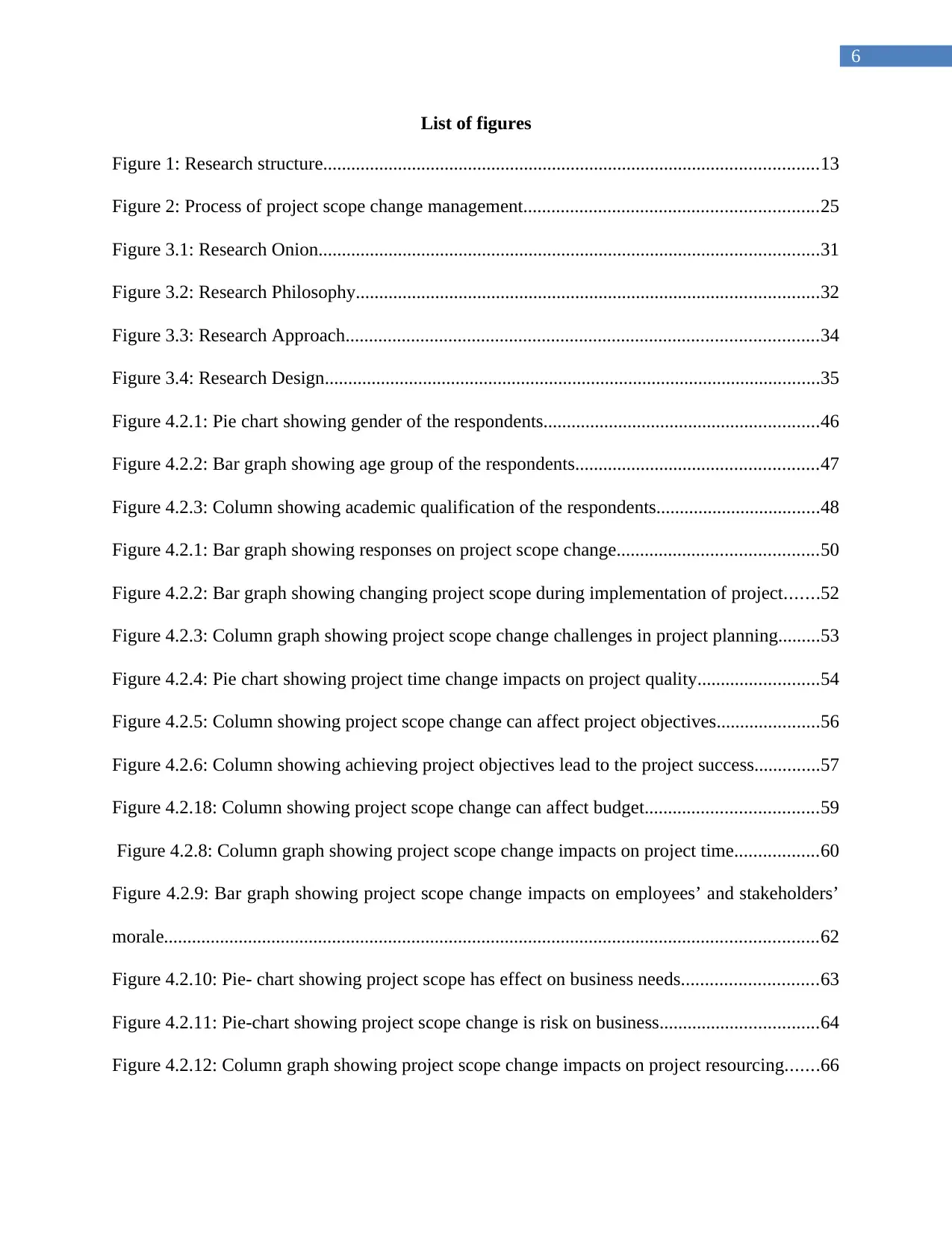
6
List of figures
Figure 1: Research structure..........................................................................................................13
Figure 2: Process of project scope change management...............................................................25
Figure 3.1: Research Onion...........................................................................................................31
Figure 3.2: Research Philosophy...................................................................................................32
Figure 3.3: Research Approach.....................................................................................................34
Figure 3.4: Research Design..........................................................................................................35
Figure 4.2.1: Pie chart showing gender of the respondents...........................................................46
Figure 4.2.2: Bar graph showing age group of the respondents....................................................47
Figure 4.2.3: Column showing academic qualification of the respondents...................................48
Figure 4.2.1: Bar graph showing responses on project scope change...........................................50
Figure 4.2.2: Bar graph showing changing project scope during implementation of project.......52
Figure 4.2.3: Column graph showing project scope change challenges in project planning.........53
Figure 4.2.4: Pie chart showing project time change impacts on project quality..........................54
Figure 4.2.5: Column showing project scope change can affect project objectives......................56
Figure 4.2.6: Column showing achieving project objectives lead to the project success..............57
Figure 4.2.18: Column showing project scope change can affect budget.....................................59
Figure 4.2.8: Column graph showing project scope change impacts on project time..................60
Figure 4.2.9: Bar graph showing project scope change impacts on employees’ and stakeholders’
morale............................................................................................................................................62
Figure 4.2.10: Pie- chart showing project scope has effect on business needs.............................63
Figure 4.2.11: Pie-chart showing project scope change is risk on business..................................64
Figure 4.2.12: Column graph showing project scope change impacts on project resourcing.......66
List of figures
Figure 1: Research structure..........................................................................................................13
Figure 2: Process of project scope change management...............................................................25
Figure 3.1: Research Onion...........................................................................................................31
Figure 3.2: Research Philosophy...................................................................................................32
Figure 3.3: Research Approach.....................................................................................................34
Figure 3.4: Research Design..........................................................................................................35
Figure 4.2.1: Pie chart showing gender of the respondents...........................................................46
Figure 4.2.2: Bar graph showing age group of the respondents....................................................47
Figure 4.2.3: Column showing academic qualification of the respondents...................................48
Figure 4.2.1: Bar graph showing responses on project scope change...........................................50
Figure 4.2.2: Bar graph showing changing project scope during implementation of project.......52
Figure 4.2.3: Column graph showing project scope change challenges in project planning.........53
Figure 4.2.4: Pie chart showing project time change impacts on project quality..........................54
Figure 4.2.5: Column showing project scope change can affect project objectives......................56
Figure 4.2.6: Column showing achieving project objectives lead to the project success..............57
Figure 4.2.18: Column showing project scope change can affect budget.....................................59
Figure 4.2.8: Column graph showing project scope change impacts on project time..................60
Figure 4.2.9: Bar graph showing project scope change impacts on employees’ and stakeholders’
morale............................................................................................................................................62
Figure 4.2.10: Pie- chart showing project scope has effect on business needs.............................63
Figure 4.2.11: Pie-chart showing project scope change is risk on business..................................64
Figure 4.2.12: Column graph showing project scope change impacts on project resourcing.......66
Paraphrase This Document
Need a fresh take? Get an instant paraphrase of this document with our AI Paraphraser

7
Figure 4.2.13: bar graph showing poorly defined initial requirements can lead to project scope
change............................................................................................................................................67
Figure 4.2.14: Bar graph showing IT Technologies can impact on project scope change............68
Figure 4.2.15: Bar graph showing Information Technologies help to define project scope.........70
Figure 4.2.16: Scatter diagram showing control project scope change.........................................71
Figure 4.2.17: Bar graph showing clarity in initial stage leads to project scope change...............72
Figure 4.2.18: Bar graph showing project scope change creates uncertainties in project.............73
Figure 4.2.19: Pie-chart showing project scope change can create challenge in functional
requirement....................................................................................................................................75
Figure 4.2.20: Line graph showing technical requirement poses issue project scope change.......76
Figure 4.2.21: Scatter diagram showing project objectives can be measured through Key
Performance Indicators..................................................................................................................78
Figure 4.2.22: Bar graph showing project scope change can disrupt the project objectives.........79
Figure 4.2.23: Pie-chart showing project scope change can occur in design phase......................80
Figure 4.2.23: Column graph showing causes of project scope change........................................82
Figure 4.2.25: Bar graph showing challenges facing in project scope in Omantel
Telecommunications......................................................................................................................83
Figure 4.2.26: Line graph showing project time change can impact on project quality................85
Figure 4.2.13: bar graph showing poorly defined initial requirements can lead to project scope
change............................................................................................................................................67
Figure 4.2.14: Bar graph showing IT Technologies can impact on project scope change............68
Figure 4.2.15: Bar graph showing Information Technologies help to define project scope.........70
Figure 4.2.16: Scatter diagram showing control project scope change.........................................71
Figure 4.2.17: Bar graph showing clarity in initial stage leads to project scope change...............72
Figure 4.2.18: Bar graph showing project scope change creates uncertainties in project.............73
Figure 4.2.19: Pie-chart showing project scope change can create challenge in functional
requirement....................................................................................................................................75
Figure 4.2.20: Line graph showing technical requirement poses issue project scope change.......76
Figure 4.2.21: Scatter diagram showing project objectives can be measured through Key
Performance Indicators..................................................................................................................78
Figure 4.2.22: Bar graph showing project scope change can disrupt the project objectives.........79
Figure 4.2.23: Pie-chart showing project scope change can occur in design phase......................80
Figure 4.2.23: Column graph showing causes of project scope change........................................82
Figure 4.2.25: Bar graph showing challenges facing in project scope in Omantel
Telecommunications......................................................................................................................83
Figure 4.2.26: Line graph showing project time change can impact on project quality................85
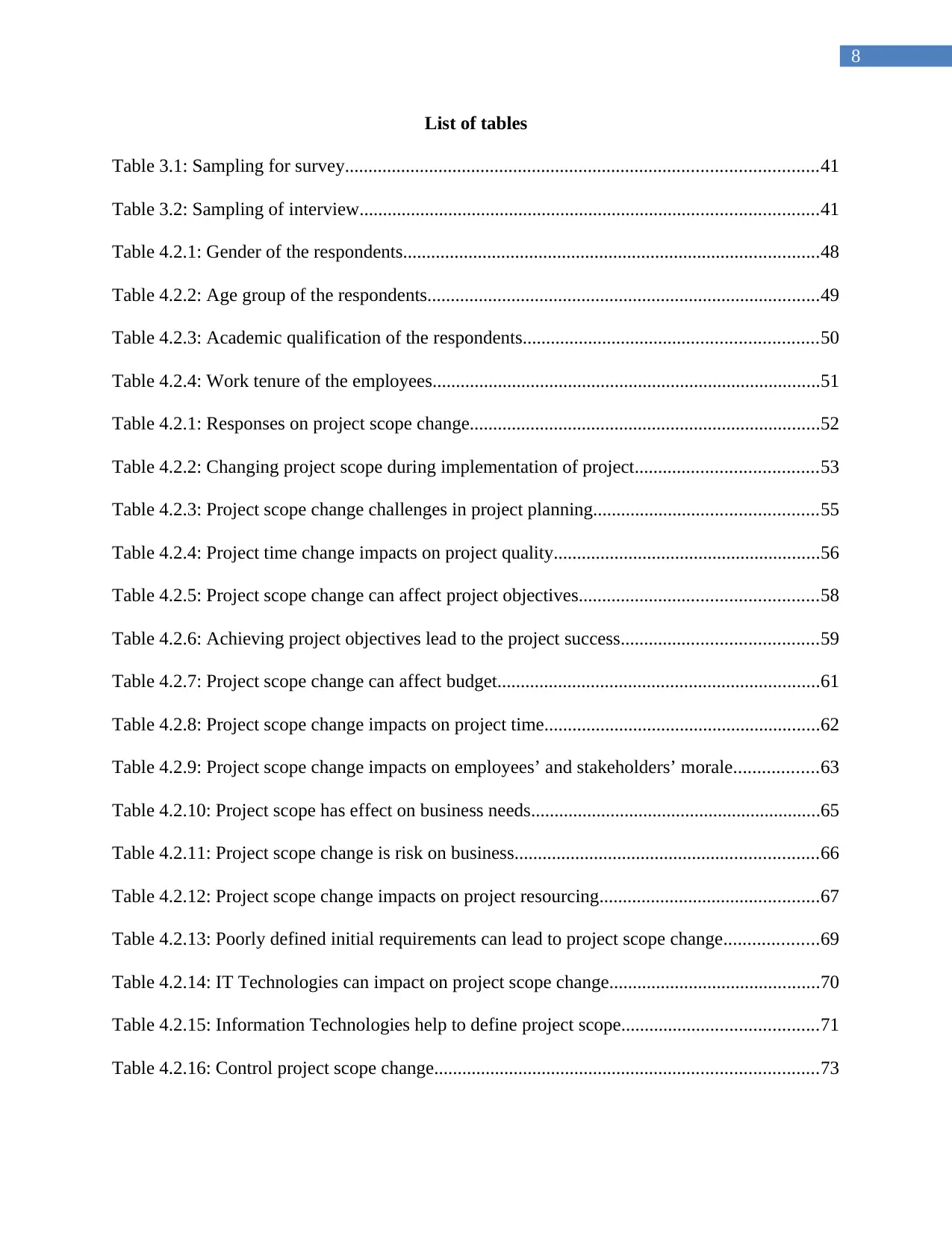
8
List of tables
Table 3.1: Sampling for survey.....................................................................................................41
Table 3.2: Sampling of interview..................................................................................................41
Table 4.2.1: Gender of the respondents.........................................................................................48
Table 4.2.2: Age group of the respondents....................................................................................49
Table 4.2.3: Academic qualification of the respondents...............................................................50
Table 4.2.4: Work tenure of the employees...................................................................................51
Table 4.2.1: Responses on project scope change...........................................................................52
Table 4.2.2: Changing project scope during implementation of project.......................................53
Table 4.2.3: Project scope change challenges in project planning................................................55
Table 4.2.4: Project time change impacts on project quality.........................................................56
Table 4.2.5: Project scope change can affect project objectives...................................................58
Table 4.2.6: Achieving project objectives lead to the project success..........................................59
Table 4.2.7: Project scope change can affect budget.....................................................................61
Table 4.2.8: Project scope change impacts on project time...........................................................62
Table 4.2.9: Project scope change impacts on employees’ and stakeholders’ morale..................63
Table 4.2.10: Project scope has effect on business needs..............................................................65
Table 4.2.11: Project scope change is risk on business.................................................................66
Table 4.2.12: Project scope change impacts on project resourcing...............................................67
Table 4.2.13: Poorly defined initial requirements can lead to project scope change....................69
Table 4.2.14: IT Technologies can impact on project scope change.............................................70
Table 4.2.15: Information Technologies help to define project scope..........................................71
Table 4.2.16: Control project scope change..................................................................................73
List of tables
Table 3.1: Sampling for survey.....................................................................................................41
Table 3.2: Sampling of interview..................................................................................................41
Table 4.2.1: Gender of the respondents.........................................................................................48
Table 4.2.2: Age group of the respondents....................................................................................49
Table 4.2.3: Academic qualification of the respondents...............................................................50
Table 4.2.4: Work tenure of the employees...................................................................................51
Table 4.2.1: Responses on project scope change...........................................................................52
Table 4.2.2: Changing project scope during implementation of project.......................................53
Table 4.2.3: Project scope change challenges in project planning................................................55
Table 4.2.4: Project time change impacts on project quality.........................................................56
Table 4.2.5: Project scope change can affect project objectives...................................................58
Table 4.2.6: Achieving project objectives lead to the project success..........................................59
Table 4.2.7: Project scope change can affect budget.....................................................................61
Table 4.2.8: Project scope change impacts on project time...........................................................62
Table 4.2.9: Project scope change impacts on employees’ and stakeholders’ morale..................63
Table 4.2.10: Project scope has effect on business needs..............................................................65
Table 4.2.11: Project scope change is risk on business.................................................................66
Table 4.2.12: Project scope change impacts on project resourcing...............................................67
Table 4.2.13: Poorly defined initial requirements can lead to project scope change....................69
Table 4.2.14: IT Technologies can impact on project scope change.............................................70
Table 4.2.15: Information Technologies help to define project scope..........................................71
Table 4.2.16: Control project scope change..................................................................................73
⊘ This is a preview!⊘
Do you want full access?
Subscribe today to unlock all pages.

Trusted by 1+ million students worldwide
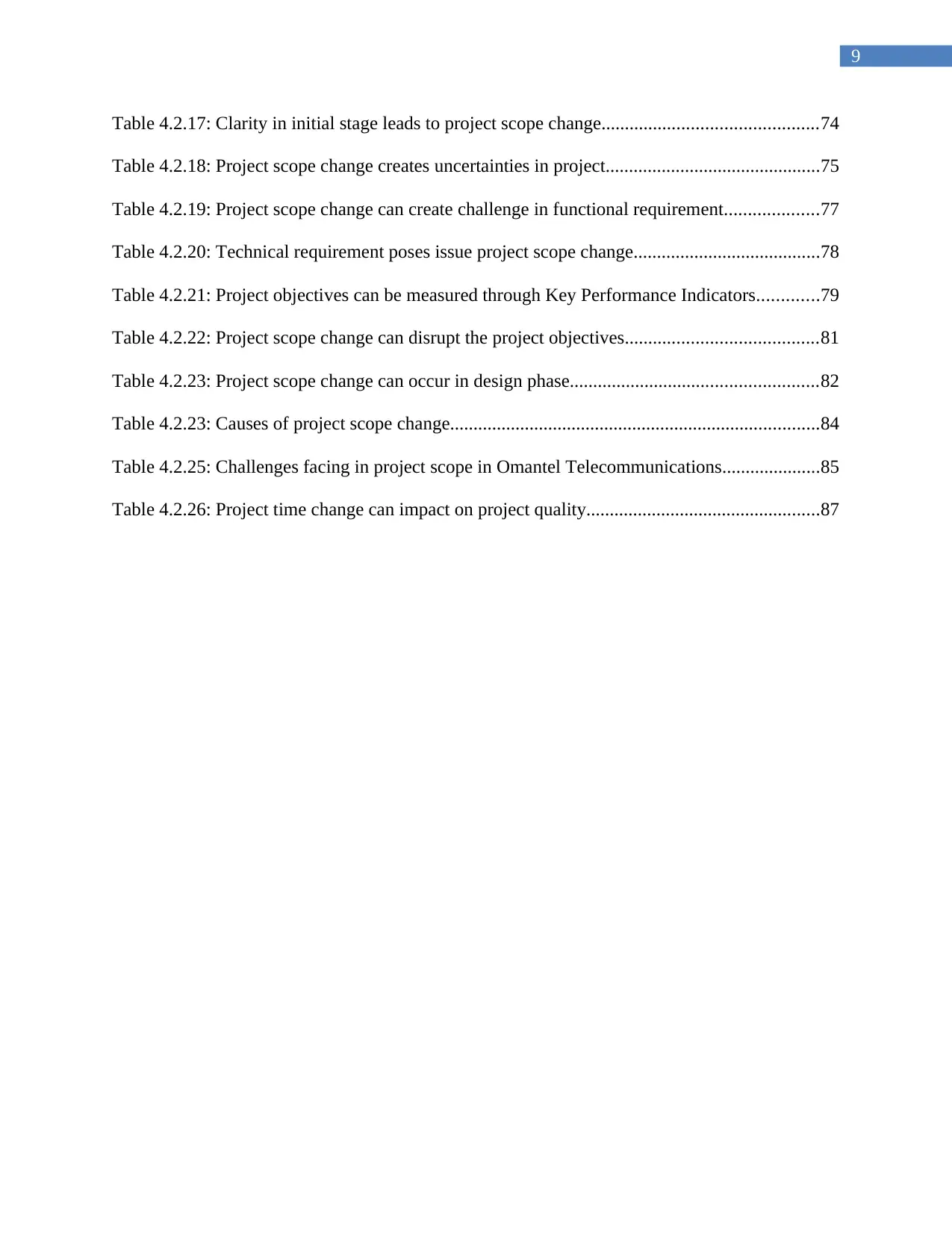
9
Table 4.2.17: Clarity in initial stage leads to project scope change..............................................74
Table 4.2.18: Project scope change creates uncertainties in project..............................................75
Table 4.2.19: Project scope change can create challenge in functional requirement....................77
Table 4.2.20: Technical requirement poses issue project scope change........................................78
Table 4.2.21: Project objectives can be measured through Key Performance Indicators.............79
Table 4.2.22: Project scope change can disrupt the project objectives.........................................81
Table 4.2.23: Project scope change can occur in design phase.....................................................82
Table 4.2.23: Causes of project scope change...............................................................................84
Table 4.2.25: Challenges facing in project scope in Omantel Telecommunications.....................85
Table 4.2.26: Project time change can impact on project quality..................................................87
Table 4.2.17: Clarity in initial stage leads to project scope change..............................................74
Table 4.2.18: Project scope change creates uncertainties in project..............................................75
Table 4.2.19: Project scope change can create challenge in functional requirement....................77
Table 4.2.20: Technical requirement poses issue project scope change........................................78
Table 4.2.21: Project objectives can be measured through Key Performance Indicators.............79
Table 4.2.22: Project scope change can disrupt the project objectives.........................................81
Table 4.2.23: Project scope change can occur in design phase.....................................................82
Table 4.2.23: Causes of project scope change...............................................................................84
Table 4.2.25: Challenges facing in project scope in Omantel Telecommunications.....................85
Table 4.2.26: Project time change can impact on project quality..................................................87
Paraphrase This Document
Need a fresh take? Get an instant paraphrase of this document with our AI Paraphraser

10
Chapter 1: Introduction
In this chapter, the main focus is to highlight research background, aim, objectives,
questions and most importantly the problem statement. In the end of this chapter, the structure of
the research and limitation of the study has been prescribed.
1.1 Background of the Study
In any project management framework, the ultimate objective is to have the right results
at the end of the project. Moreover, result must be achieved through maintaining and fulfilling
the scope. In completing the project, there are mainly two types of constraints, budget and
deadlines. In failing the project, these two principles are responsible. As stated by Larson and
Gray (2013), implementing the project process and requirements of the project are a feasible
approach to create a project management scope. Projects must be managed through observing the
success and success of any project is depended on the schedule, cost, budget, framework and
appropriate methodology of the project. However, most importantly, stakeholders of the projects
look at the completion of specific goals and outcomes. Finishing the project on time requires
framing the requirement for the project. Planning is a significant part of the project in setting the
scope of the project and after the planning; it is needed to agree with the delivering of the
intended outcomes. Including the project, the scope must be followed throughout the lifecycle of
the project. (Kerzner 2013) agreed about this maintaining project scope is the process of
managing all the steps and work that are required to finish the project on time, successfully.
Moreover, project scope can be defined as the project planning that is associated with a list of
project objectives, features, deliverables, tasks and functions. In specific, project scope is the
ultimate needs of the project that should be achieved in delivering the project.
Chapter 1: Introduction
In this chapter, the main focus is to highlight research background, aim, objectives,
questions and most importantly the problem statement. In the end of this chapter, the structure of
the research and limitation of the study has been prescribed.
1.1 Background of the Study
In any project management framework, the ultimate objective is to have the right results
at the end of the project. Moreover, result must be achieved through maintaining and fulfilling
the scope. In completing the project, there are mainly two types of constraints, budget and
deadlines. In failing the project, these two principles are responsible. As stated by Larson and
Gray (2013), implementing the project process and requirements of the project are a feasible
approach to create a project management scope. Projects must be managed through observing the
success and success of any project is depended on the schedule, cost, budget, framework and
appropriate methodology of the project. However, most importantly, stakeholders of the projects
look at the completion of specific goals and outcomes. Finishing the project on time requires
framing the requirement for the project. Planning is a significant part of the project in setting the
scope of the project and after the planning; it is needed to agree with the delivering of the
intended outcomes. Including the project, the scope must be followed throughout the lifecycle of
the project. (Kerzner 2013) agreed about this maintaining project scope is the process of
managing all the steps and work that are required to finish the project on time, successfully.
Moreover, project scope can be defined as the project planning that is associated with a list of
project objectives, features, deliverables, tasks and functions. In specific, project scope is the
ultimate needs of the project that should be achieved in delivering the project.
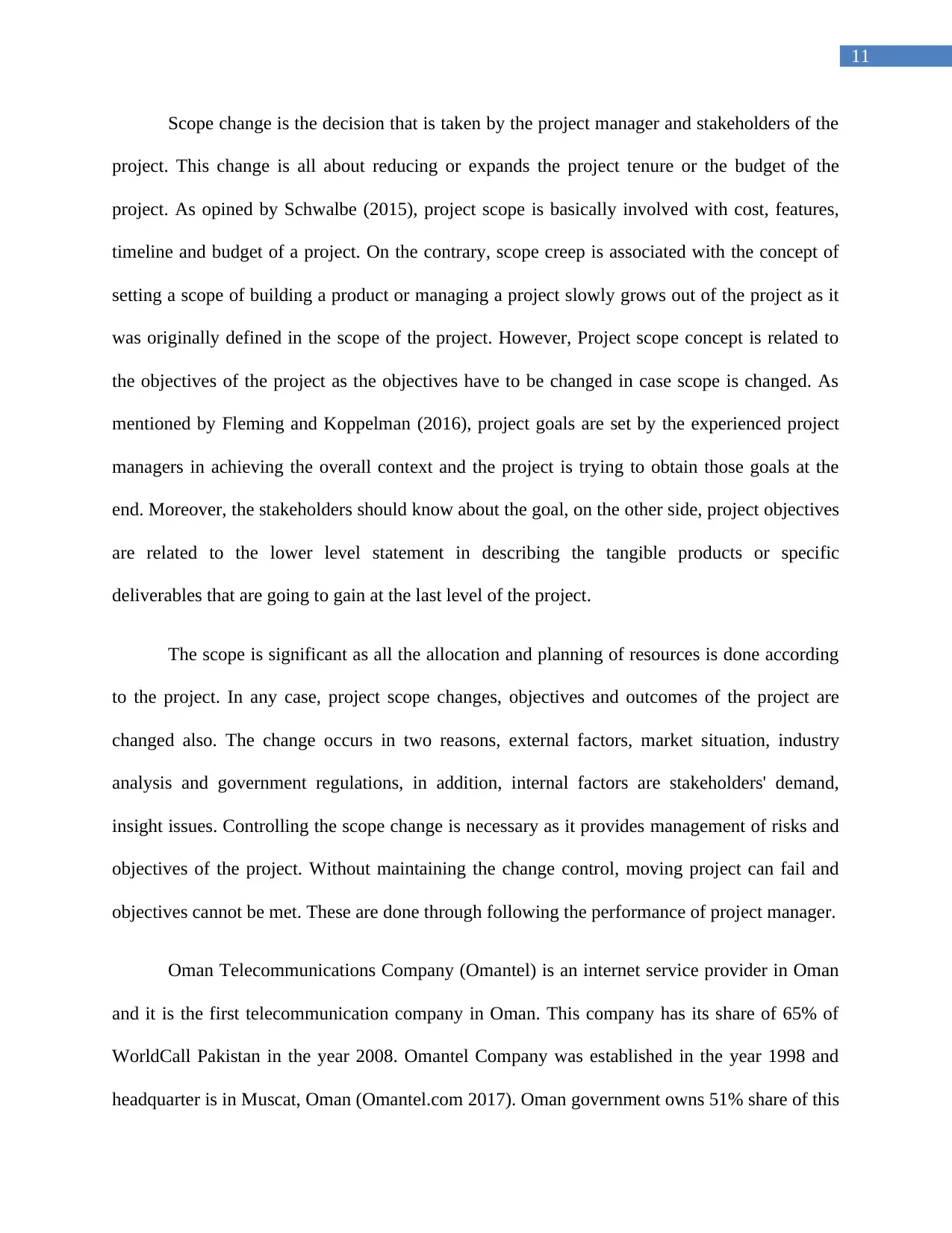
11
Scope change is the decision that is taken by the project manager and stakeholders of the
project. This change is all about reducing or expands the project tenure or the budget of the
project. As opined by Schwalbe (2015), project scope is basically involved with cost, features,
timeline and budget of a project. On the contrary, scope creep is associated with the concept of
setting a scope of building a product or managing a project slowly grows out of the project as it
was originally defined in the scope of the project. However, Project scope concept is related to
the objectives of the project as the objectives have to be changed in case scope is changed. As
mentioned by Fleming and Koppelman (2016), project goals are set by the experienced project
managers in achieving the overall context and the project is trying to obtain those goals at the
end. Moreover, the stakeholders should know about the goal, on the other side, project objectives
are related to the lower level statement in describing the tangible products or specific
deliverables that are going to gain at the last level of the project.
The scope is significant as all the allocation and planning of resources is done according
to the project. In any case, project scope changes, objectives and outcomes of the project are
changed also. The change occurs in two reasons, external factors, market situation, industry
analysis and government regulations, in addition, internal factors are stakeholders' demand,
insight issues. Controlling the scope change is necessary as it provides management of risks and
objectives of the project. Without maintaining the change control, moving project can fail and
objectives cannot be met. These are done through following the performance of project manager.
Oman Telecommunications Company (Omantel) is an internet service provider in Oman
and it is the first telecommunication company in Oman. This company has its share of 65% of
WorldCall Pakistan in the year 2008. Omantel Company was established in the year 1998 and
headquarter is in Muscat, Oman (Omantel.com 2017). Oman government owns 51% share of this
Scope change is the decision that is taken by the project manager and stakeholders of the
project. This change is all about reducing or expands the project tenure or the budget of the
project. As opined by Schwalbe (2015), project scope is basically involved with cost, features,
timeline and budget of a project. On the contrary, scope creep is associated with the concept of
setting a scope of building a product or managing a project slowly grows out of the project as it
was originally defined in the scope of the project. However, Project scope concept is related to
the objectives of the project as the objectives have to be changed in case scope is changed. As
mentioned by Fleming and Koppelman (2016), project goals are set by the experienced project
managers in achieving the overall context and the project is trying to obtain those goals at the
end. Moreover, the stakeholders should know about the goal, on the other side, project objectives
are related to the lower level statement in describing the tangible products or specific
deliverables that are going to gain at the last level of the project.
The scope is significant as all the allocation and planning of resources is done according
to the project. In any case, project scope changes, objectives and outcomes of the project are
changed also. The change occurs in two reasons, external factors, market situation, industry
analysis and government regulations, in addition, internal factors are stakeholders' demand,
insight issues. Controlling the scope change is necessary as it provides management of risks and
objectives of the project. Without maintaining the change control, moving project can fail and
objectives cannot be met. These are done through following the performance of project manager.
Oman Telecommunications Company (Omantel) is an internet service provider in Oman
and it is the first telecommunication company in Oman. This company has its share of 65% of
WorldCall Pakistan in the year 2008. Omantel Company was established in the year 1998 and
headquarter is in Muscat, Oman (Omantel.com 2017). Oman government owns 51% share of this
⊘ This is a preview!⊘
Do you want full access?
Subscribe today to unlock all pages.

Trusted by 1+ million students worldwide
1 out of 102
Related Documents
Your All-in-One AI-Powered Toolkit for Academic Success.
+13062052269
info@desklib.com
Available 24*7 on WhatsApp / Email
![[object Object]](/_next/static/media/star-bottom.7253800d.svg)
Unlock your academic potential
Copyright © 2020–2025 A2Z Services. All Rights Reserved. Developed and managed by ZUCOL.





